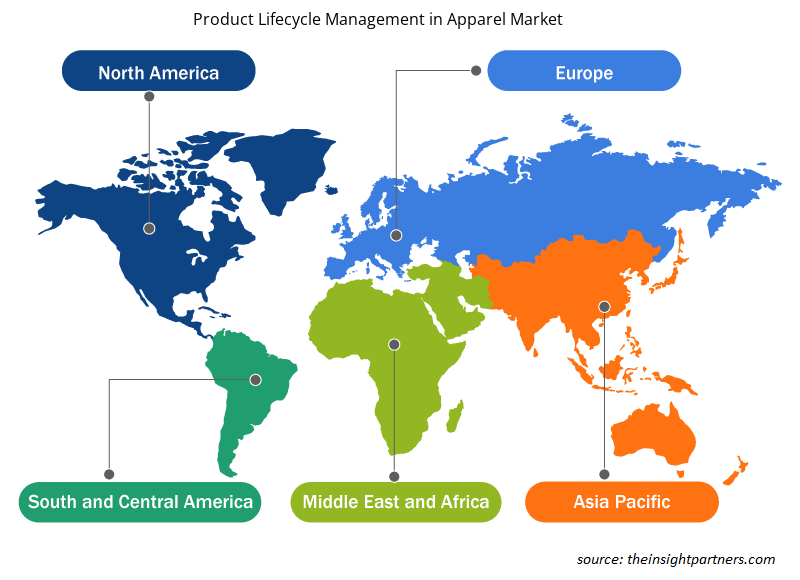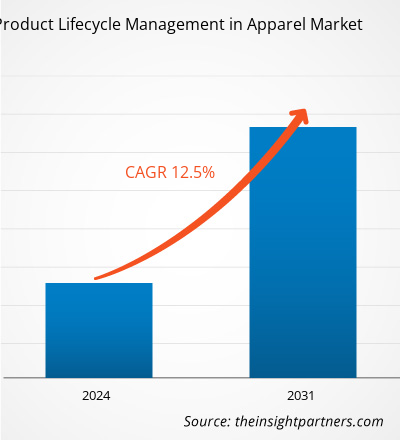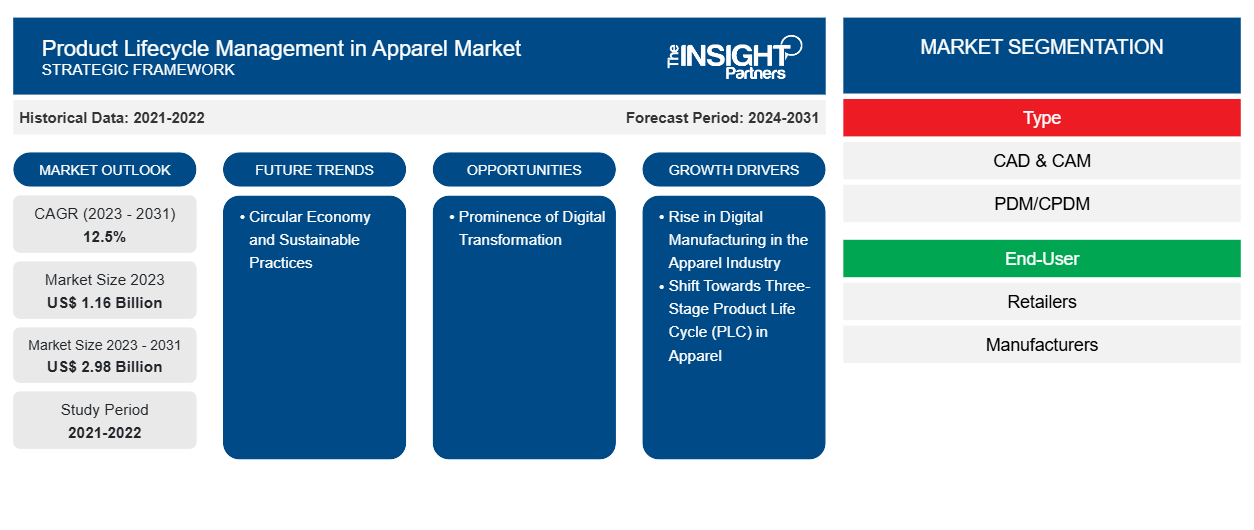La taille du marché de la gestion du cycle de vie des produits dans l'habillement devrait atteindre 2,98 milliards USD d'ici 2031, contre 1,16 milliard USD en 2023. Le marché devrait enregistrer un TCAC de 12,5 % en 2023-2031. L'économie circulaire et les pratiques durables ainsi que l'accent mis sur la transformation numérique devraient rester les principales tendances du marché de la gestion du cycle de vie des produits dans l'habillement.lifecycle management in apparel market size is projected to reach US$ 2.98 billion by 2031 from US$ 1.16 billion in 2023. The market is expected to register a CAGR of 12.5% in 2023–2031. Circular economy & sustainable practices and emphasis on digital transformation are likely to remain key product lifecycle management in apparel market trends.
Analyse du marché de la gestion du cycle de vie des produits dans le secteur de l'habillement
L'industrie de la mode se caractérise par des changements rapides dans les goûts des consommateurs et par la réduction de la durée de vie des produits, ce qui ajoute à sa complexité. Ces changements créent des difficultés et des perspectives dans de nombreux domaines du secteur, tels que la fabrication, les méthodes de production, les normes et les efforts de publicité et de marketing.
Aperçu du marché de la gestion du cycle de vie des produits dans l'habillement
Dans l'industrie de l'habillement, la gestion du cycle de vie des produits (PLM) est une approche stratégique visant à superviser l'ensemble du parcours d'un produit, de sa conception et de son développement initiaux à son lancement officiel, son service et son élimination. Cette méthode complète implique la gestion de toutes les activités liées au cycle de vie d'un produit, telles que la fabrication, la commercialisation et le retrait éventuel du marché. Grâce à l'approche PLM, l'industrie peut analyser l'accueil réservé à un produit par le marché au fil du temps, y compris les fluctuations importantes des ventes.PLM) is a strategic approach to overseeing the entire journey of a product, from its initial design and development to its official launch, service, and disposal. This comprehensive method involves managing all the activities related to a product's lifecycle, such as manufacturing, marketing, and eventual removal from the market. Through the PLM approach, the industry can analyze how well a product is received by the market over time, including significant fluctuations in sales.
Personnalisez ce rapport en fonction de vos besoins
Vous bénéficierez d'une personnalisation gratuite de n'importe quel rapport, y compris de certaines parties de ce rapport, d'une analyse au niveau des pays, d'un pack de données Excel, ainsi que d'offres et de remises exceptionnelles pour les start-ups et les universités.
-
Obtenez les principales tendances clés du marché de ce rapport.Cet échantillon GRATUIT comprendra une analyse de données, allant des tendances du marché aux estimations et prévisions.
Gestion du cycle de vie des produits dans le secteur de l'habillement : facteurs moteurs et opportunités
L'essor de la fabrication numérique dans l'industrie du vêtement va stimuler le marché
L'essor de la fabrication numérique dans l'industrie du vêtement devrait avoir un impact significatif sur la nécessité de systèmes de gestion du cycle de vie des produits (PLM) robustes et fiables. Cela est dû en grande partie aux processus complexes impliqués dans la fabrication numérique, notamment la conception, le design, la planification et l'exécution, qui nécessitent tous une utilisation intensive de logiciels PLM tels que la CAO et la FAO. En conséquence, l'expansion de la fabrication numérique devrait accroître le besoin de systèmes PLM, favorisant ainsi les progrès de la gestion du cycle de vie des produits sur le marché du vêtement au cours de la période prévue.
Importance de la transformation numérique
L’évolution continue vers la numérisation a ouvert de nouvelles perspectives d’innovation, intégrant des technologies avancées telles que l’apprentissage automatique (ML), l’intelligence artificielle (IA), la robotique et l’Internet des objets (IoT) pour ouvrir la voie à l’ère de la quatrième révolution industrielle (Industrie 4.0). Dans l’Industrie 4.0, le mélange de l’électronique et des technologies de l’information facilite l’intégration numérique transparente des aspects physiques, numériques et biologiques de la vie humaine moderne. Cela marque un changement important pour l’industrie manufacturière, en particulier dans la production de biens fabriqués en série comme les vêtements et les chaussures, car l’Industrie 4.0 initie une transformation révolutionnaire. digitalization has opened up new avenues for innovation, incorporating advanced technologies such as machine learning (ML), artificial intelligence (AI), robotics, and the Internet of Things (IoT) to lead the way into the era of the fourth industrial revolution (Industry 4.0). In Industry 4.0, the blending of electronics and information technology facilitates the seamless digital integration of the physical, digital, and biological aspects of modern human life. This marks a significant change for the manufacturing industry, particularly in the production of mass-manufactured goods like clothing and footwear, as Industry 4.0 instigates a revolutionary transformation.
Analyse de segmentation du rapport sur la gestion du cycle de vie des produits dans le marché de l'habillement
Les segments clés qui ont contribué à la dérivation de la gestion du cycle de vie du produit dans l’analyse du marché de l’habillement sont le type et l’utilisateur final.
- En fonction du type, le marché est divisé en deux segments : CAO et FAO et PDM/CPDM. Le segment CAO et FAO détenait une part de marché importante en 2023.
- En termes d’utilisateurs finaux, le marché est segmenté en détaillants,fabricants et autres. Le segment des fabricants détenait une part substantielle du marché en 2023.
Analyse des parts de marché de la gestion du cycle de vie des produits dans le secteur de l'habillement par zone géographique
La portée géographique du rapport sur la gestion du cycle de vie des produits dans le marché de l'habillement est principalement divisée en cinq régions : Amérique du Nord, Asie-Pacifique, Europe, Moyen-Orient et Afrique, et Amérique du Sud/Amérique du Sud et centrale.
La gestion du cycle de vie des produits sur le marché de l'habillement en Europe englobe la gestion de l'ensemble du cycle de vie des produits de mode, en répondant aux défis uniques posés par les tendances en constante évolution et les préférences des consommateurs. Le marché devrait connaître une croissance significative et l'adaptation à la dynamique changeante du marché présente des opportunités pour les entreprises du secteur européen de l'habillement.
Gestion du cycle de vie des produits sur le marché de l'habillement : aperçu régional
Les tendances et facteurs régionaux influençant la gestion du cycle de vie des produits sur le marché de l'habillement tout au long de la période de prévision ont été expliqués en détail par les analystes d'Insight Partners. Cette section traite également des segments et de la géographie de la gestion du cycle de vie des produits sur le marché de l'habillement en Amérique du Nord, en Europe, en Asie-Pacifique, au Moyen-Orient et en Afrique, ainsi qu'en Amérique du Sud et en Amérique centrale.

- Obtenez les données régionales spécifiques pour la gestion du cycle de vie des produits sur le marché de l'habillement
Portée du rapport sur la gestion du cycle de vie des produits dans le marché de l'habillement
| Attribut de rapport | Détails |
|---|---|
| Taille du marché en 2023 | 1,16 milliard de dollars américains |
| Taille du marché d'ici 2031 | 2,98 milliards de dollars américains |
| Taux de croissance annuel composé mondial (2023-2031) | 12,5% |
| Données historiques | 2021-2022 |
| Période de prévision | 2024-2031 |
| Segments couverts |
Par type
|
| Régions et pays couverts |
Amérique du Nord
|
| Leaders du marché et profils d'entreprises clés |
|
Densité des acteurs du marché : comprendre son impact sur la dynamique des entreprises
Le marché de la gestion du cycle de vie des produits dans le secteur de l'habillement connaît une croissance rapide, tirée par la demande croissante des utilisateurs finaux en raison de facteurs tels que l'évolution des préférences des consommateurs, les avancées technologiques et une plus grande sensibilisation aux avantages du produit. À mesure que la demande augmente, les entreprises élargissent leurs offres, innovent pour répondre aux besoins des consommateurs et capitalisent sur les tendances émergentes, ce qui alimente davantage la croissance du marché.
La densité des acteurs du marché fait référence à la répartition des entreprises ou des sociétés opérant sur un marché ou un secteur particulier. Elle indique le nombre de concurrents (acteurs du marché) présents sur un marché donné par rapport à sa taille ou à sa valeur marchande totale.
Les principales entreprises opérant sur le marché de la gestion du cycle de vie des produits dans l'habillement sont :
- C-DESIGN Mode
- Solution générée par ordinateur
- Dassault Systèmes
- EFI Optitex
- Gerber Technology LLC
- Infor Inc.
Avis de non-responsabilité : les sociétés répertoriées ci-dessus ne sont pas classées dans un ordre particulier.

- Obtenez un aperçu des principaux acteurs clés du marché de la gestion du cycle de vie des produits sur le marché de l'habillement
Gestion du cycle de vie des produits sur le marché de l'habillement : actualités et développements récents
La gestion du cycle de vie des produits sur le marché de l'habillement est évaluée en collectant des données qualitatives et quantitatives issues de recherches primaires et secondaires, qui comprennent d'importantes publications d'entreprise, des données d'association et des bases de données. Voici une liste des évolutions du marché :
- Aptean, un fournisseur mondial de solutions logicielles d'entreprise critiques, a annoncé l'acquisition de Momentis, un fournisseur de solutions logicielles spécialement conçues pour les secteurs de la mode, de l'habillement, de la chaussure, du textile et des accessoires.
(Source : Aptean Inc., Communiqué de presse, 2024)
- Infor®, l'entreprise spécialisée dans le cloud industriel, a annoncé aujourd'hui la disponibilité d'une interface dédiée entre Made2Flow, une entreprise technologique spécialisée dans l'analyse et la validation des données environnementales dans l'industrie de la mode, et la gestion du cycle de vie des produits (PLM) d'Infor. L'interface facilitera le traitement des données et la visibilité complète pour les marques de mode mondiales qui cherchent à accroître la transparence de la chaîne d'approvisionnement de production. Elle prendra en charge la traçabilité et la mesure de l'impact sur les niveaux 1 à 4.
(Source : Infor, communiqué de presse, 2023)
Rapport sur la gestion du cycle de vie des produits dans le marché de l'habillement : couverture et livrables
Le rapport « Gestion du cycle de vie des produits sur le marché de l’habillement : taille et prévisions (2021-2031) » fournit une analyse détaillée du marché couvrant les domaines ci-dessous :
- Taille du marché et prévisions aux niveaux mondial, régional et national pour tous les segments de marché clés couverts par le périmètre
- Dynamique du marché, comme les facteurs moteurs, les contraintes et les opportunités clés
- Principales tendances futures
- Analyse détaillée des cinq forces de PEST/Porter et SWOT
- Analyse du marché mondial et régional couvrant les principales tendances du marché, les principaux acteurs, les réglementations et les développements récents du marché
- Analyse du paysage industriel et de la concurrence couvrant la concentration du marché, l'analyse de la carte thermique, les principaux acteurs et les développements récents
- Profils d'entreprise détaillés
- Analyse historique (2 ans), année de base, prévision (7 ans) avec TCAC
- Analyse PEST et SWOT
- Taille du marché Valeur / Volume - Mondial, Régional, Pays
- Industrie et paysage concurrentiel
- Ensemble de données Excel
Rapports récents
Rapports connexes
Témoignages
Raison d'acheter
- Prise de décision éclairée
- Compréhension de la dynamique du marché
- Analyse concurrentielle
- Connaissances clients
- Prévisions de marché
- Atténuation des risques
- Planification stratégique
- Justification des investissements
- Identification des marchés émergents
- Amélioration des stratégies marketing
- Amélioration de l'efficacité opérationnelle
- Alignement sur les tendances réglementaires























 Obtenez un échantillon gratuit pour - Gestion du cycle de vie des produits sur le marché de l'habillement
Obtenez un échantillon gratuit pour - Gestion du cycle de vie des produits sur le marché de l'habillement